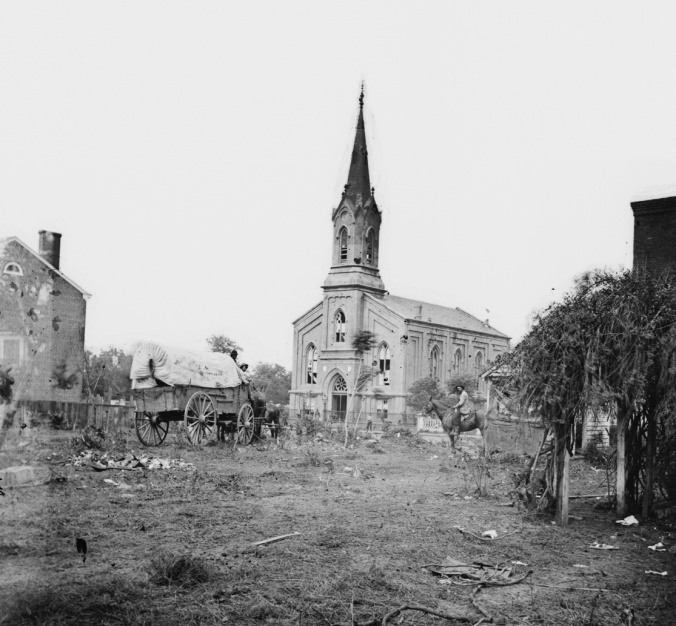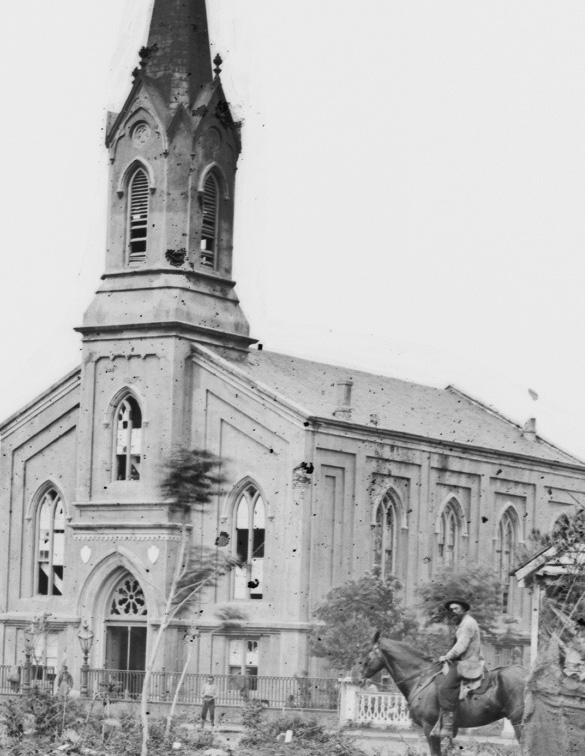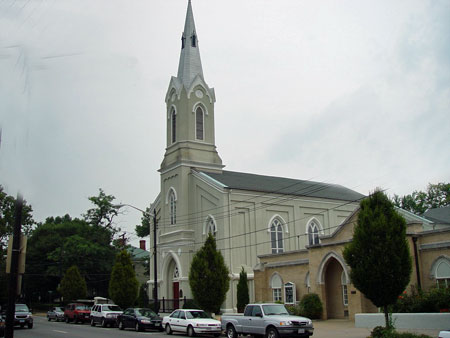From Hennessy (see here for an earlier post on damage in town):
Fredericksburg had eight churches at the time of the Civil War, and all of them played a central part in the town’s thrice-repeated role as a Union hospital. Of them all, by far the best documented is the Fredericksburg Baptist Church. The sanctuary, shown below, was just seven years old when war visited its walls on December 13, 1862. That morning, Union hospital workers arrived and cleared the main sanctuary by throwing most of the pews out the windows. Then the wounded started pouring in, using the seat cushions as beds.
 That the Baptist Church became such a visible and important hospital is a little surprising given the physical layout of the place. The doorway you see in the image opens to what in 1862 was probably a chapel or meeting room. The main sanctuary is upstairs, reached by one of two fairly arduous stairways. Getting wounded into the main sanctuary meant carrying them up the stairs–no easy task.
That the Baptist Church became such a visible and important hospital is a little surprising given the physical layout of the place. The doorway you see in the image opens to what in 1862 was probably a chapel or meeting room. The main sanctuary is upstairs, reached by one of two fairly arduous stairways. Getting wounded into the main sanctuary meant carrying them up the stairs–no easy task.
This is one of four buildings in town that we can be certain had Clara Barton grace its entryway during her four visits to Fredericksburg. Far more important than that, during the massive movement of wounded through Fredericksburg in 1864 (26,000 wounded in two weeks), the Baptist Church was the domain of Dr. Frank Hamilton, one of America’s premier surgeons, who had been lured out of military retirement to help treat the wounded in Fredericksburg. The use of the hospital is exceedingly well documented.
The war left the Baptist Church a mess. Resident H.W. Willenbucher later testified to the damage.
“Before the battle the church was intact, but after the battle was over I came back to town. I was out in the country with my family during the battle. I came back the morning after the battle. I saw arms and legs in the rear of the building and there was blood on the floors and mattresses inside and outside of the building. The pews had all been taken out of the building and broken up; there was not a whole bench in the place to be found; they had been used for firewood and there was evidence that they had been removed with axes. And some of the doors in the basement part of the building were gone….The buildings was in such condition that it could not be used for church purposes until after it was repaired.”
Beyond the damage done by using the building as a hospital, artillery fire also took its toll. A blowup of the image shows damage all over–windows broken, a large hole on the corner nearest the camera, and still more in the steeple. In fact, when I had the rather scary privilege of going up into the steeple several years ago, the visible shell damage remains spectacular. The central brick column supporting the steeple still has a crater in it from being struck, and the corresponding hole in the roof tells us that the shell came from the direction of Ferry Farm below the town. Still, as suggested in our previous post on damage elsewhere in town, the damage from artillery does not seem to compare with the damage done by physical use and abuse by soldiers.
A final note from the blowup: the kneewall and iron fence in front of the church remain. Here is the church today.


The Christian Index, a newspaper of the Southern Baptist Church published in Macon, Ga., contains a letter in the May 11, 1863, issue from Rev. William F. Broaddus describing some of his wartime travails. Here is an excerpt from the letter mentioning damage to the Baptist Church in Fredericksburg:
“And then to spend eight weeks in the Old Capitol prison, and finally, on the night of the 13th of December, to have my house stripped of its furniture- to have it torn to pieces by cannon balls- to see my church pierced with more than forty huge shells, tearing the bricks and slate like plough shares, while the ruthless invaders entered the audience room, and tearing up every pew, throw them out at the high windows and broke them into a thousand fragments.”
Thanks Keith. That’s a letter we have not seen hereabouts. Thanks for sharing.
For everyone’s info, Keith started his career in history at the Park many years ago…but has since immersed himself (I was tempted to say “descended into”) in academia. Occasionally he pokes his head out and sends a gold mine of source material our way, for which we are always grateful
John H.
There are at least four places on the south side of the roof (the side visible in the picture) where it is still evident that cannonballs pierced the roof, but even in the blowup of the wartime picture there are no apparent holes. I assume that since the photo was taken in 1864, the holes were repaired sometime after the 1862 battle during which the damage occurred. Who would have done this is somewhat of a mystery because the majority of church members scattered prior to the 1862 battle and the church remained virtually non-functional until May, 1865.
An interesting side story about the damage to the churches is the postwar attempts of the churches to receive reimbursement from the Federal Government for the damages. The Baptist Church petitioned for reparations circa 1868 and finally received $3,000 in 1915.
Thanks Dennis.
For those of you who don’t know, Dennis is the Administrator at the Fredericksburg Baptist Church and the outgoing president of the Virginia Baptist Historical Society: http://www.baptistheritage.org/
We are very fortunate to have someone so devoted to history caring for one of the most important historic buildings and congregations in Fredericksburg.
John H